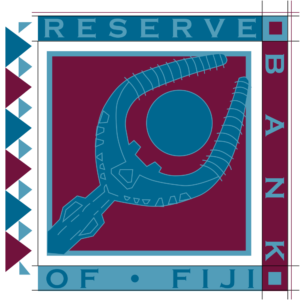
Da Afghanistan Bank is the central bank of Afghanistan. It regulates all banking and monetary transactions in Afghanistan. Established in 1939, the bank is wholly government-owned. It is active in developing policies to promote financial inclusion and a member of the Alliance for Financial Inclusion.

The Bangko Sentral ng Pilipinas is the central bank of the Philippines. It was established on July 3, 1993, pursuant to the provision of Republic Act 7653 or the New Central Bank Act of 1993 as amended by Republic Act 11211 or the New Central Bank Act of 2019. The principal author was Senator Franklin Drilon. It was signed by President Rodrigo Duterte.

The Qatar Central Bank is the central bank of Qatar.

The Reserve Bank of Fiji is the central bank of the Pacific island country of Fiji. Its responsibilities include the issue of currency, control of the money supply, currency exchange, monetary stability, promotion of sound finances, and fostering economic development.

The Central Bank of the Democratic People's Republic of Korea is North Korea's central bank. Established on December 6, 1947, it issues the North Korean wŏn. The Bank is subordinated to the Cabinet of North Korea. Since 2023, the president of the bank has been Paek Min Gwang.

The National Bank of Angola is the central bank of Angola. It is state-owned and the Government of Angola is the sole shareholder. The bank is based in Luanda, and was created in 1926, but traces its ancestry back to 1865. The National Bank of Angola is active in developing financial inclusion policy and is a member of the Alliance for Financial Inclusion.

The Bank of the Republic of Haiti is the central bank of Haiti. It was formed in 1979 from the National Bank of the Republic of Haiti, which had served as the country's bank of issue since 1910, itself succeeding the National Bank of Haiti.
The Bank of Papua New Guinea is the central bank of Papua New Guinea, which has a core mandate to ensure price stability and maintain macroeconomic growth. To achieve this, it discharges four main functions; 1. responsible for the formulation and implementation of monetary policy, 2. ensure financial system development and stability, 3. ensure the payment system remain efficient, and 4. provide a banking role to the Government. It also manages the country's foreign reserves, issue the country's currency, manages the gold and foreign exchange of Papua New Guinea.

The Central Bank of Ecuador is the central bank of the country, and an institution of the Executive Function, which has institutional, administrative, financial, and technical autonomy. It is in charge of executing the monetary policy established by the Monetary Policy and Regulation Board of Ecuador, which has been the institution's highest governing body since October 2021.

The National Bank of Panama (BNP) is one of two Panamanian government-owned banks. As of January 2009, it held deposits of about US$5 billion. The other government-owned bank is Caja de Ahorros de Panamá, with about US$1 billion in total deposits.

The Reserve Bank of Vanuatu is the central bank of Vanuatu. It was initially known as the Central Bank of Vanuatu after the nation's independence from France and the United Kingdom.

The Palestine Monetary Authority is the emerging central bank of Palestine. The PMA, located in Ramallah, was established in 1994 following the signing of the Protocol on Economic Relations between the Palestinians and Israel. It is an independent public institution responsible for the formulation and implementation of monetary and banking policies, to safeguard the banking sector and to ensure the growth of the national economy in a balanced manner.
The Global Policy Forum (GPF) is organized by the Alliance for Financial Inclusion, or AFI, as the keystone event for its membership and financial inclusion policymakers worldwide. Each year, it is co-hosted by a different member institution in a different region of the world. As of November 2023, AFI had 86 member institutions from over 80 countries, making the AFI GPF the most important and comprehensive forum for regulatory institutions with an interest in promoting financial inclusion policy. The AFI GPF is focused on developing and improving national financial inclusion strategies and policies and is used as a platform for senior financial regulators to exchange ideas as well as engage in peer-to-peer learning activities.
The Ministry of Planning and Finance administers Burma's monetary, fiscal policies and national planning.

Sierra Leone Ministry of Finance is a ministerial department of the Government of Sierra Leone, and is in charge of managing the revenue and finances of the Sierra Leone government. The ministry implements the economic policies and is responsible for public financial management. The ministry advises the President of Sierra Leone on economic issues. The headquarters of the Sierra Leone Ministry Of Finance is located on George Street in Freetown, Sierra Leone.
The Ministry of Justice and Legal Affairs of Solomon Islands is a department of the government of the Solomon Islands.

Minister of Finance of Fiji is heading the Ministry of Finance in Fiji.

The Minister of Finance, Trade, Investment and Economic Planning of Seychelles is a cabinet minister in charge of the Ministry for Finance of Seychelles, responsible for public finances of the country. The ministry is located in Central Bank Building in Victoria.

The Ministry of Finance and Treasury is a government ministry of the Solomon Islands responsible for public finances. The ministry is located in Honiara.
The Ministry of Finance is a department of the Syrian Government.















